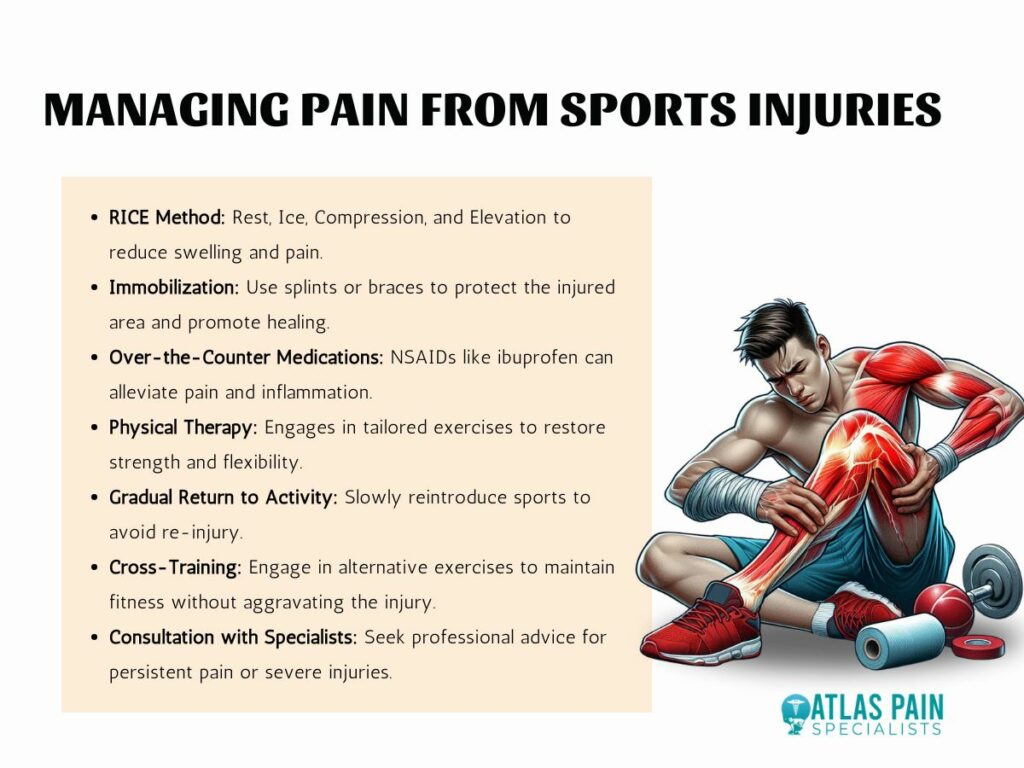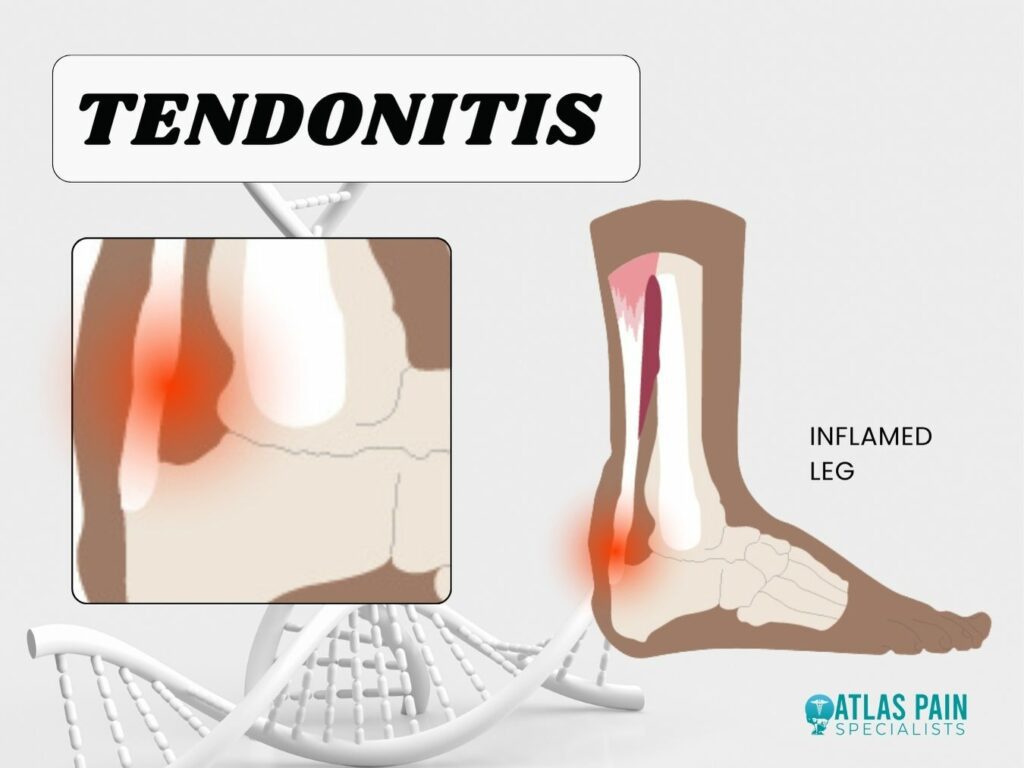

Preventing and Managing Pain from Sports Injuries
Sports injuries are prevalent among athletes at every level, from casual participants to professionals. Although engaging in sports offers significant physical and mental health benefits, the risk of injury is an ongoing concern. Knowing how to prevent and manage these injuries is crucial for sustaining long-term health and performance.
This guide explores effective strategies for injury prevention and pain management to help athletes maintain their well-being and performance.

Common Types of Sports Injuries
Sports injuries are varied and can occur depending on the activity, the intensity of participation, and individual factors like fitness level and technique. Below are some of the most common types of sports injuries:
- Sprains: Injuries to ligaments from overstretching or tearing, often affecting the ankle, knee, or wrist.
- Strains: Injuries to muscles or tendons from overstretching or overuse, commonly seen in the hamstrings or lower back.
- Fractures: Bone breaks or cracks, usually due to high-impact forces, affecting areas like the wrist or collarbone.
- Dislocations: Bones forced out of their joint position, often in the shoulder or fingers, leading to severe pain and visible deformity.
- Tendonitis: Inflammation of tendons from repetitive stress, frequently affecting the shoulder or Achilles tendon.
- Concussions: Traumatic brain injuries from blows to the head, with symptoms like headache and confusion.
- Shin Splints: Pain along the inner shinbone from overuse, often seen in runners.
- Back Pain: This can result from muscle strains or herniated discs, usually from improper lifting or twisting.
- Knee Injuries: Damage to ligaments or cartilage, causing pain and instability, often from sudden movements or impacts.
- Tennis Elbow: Inflammation of the elbow tendons from repetitive arm movements, causing pain and tenderness.
These injuries require proper prevention and treatment to ensure recovery and prevent recurrence.

How to Prevent Sports Injuries
Preventing sports injuries is crucial for maintaining long-term health and athletic performance. Here are some effective strategies:
1. Warm-Up and Cool-Down
Always start with a warm-up to prepare your muscles and joints. This should include 10-15 minutes of light aerobic activity and dynamic stretches. After your workout, cool down with light exercise and static stretches to reduce muscle stiffness.
2. Strength Training and Conditioning
Regular strength training, especially for core and stabilizing muscles, helps support joints and prevent injuries. Include sport-specific drills in your routine to improve agility and endurance, reducing the risk of overuse injuries.
3. Proper Technique and Equipment
Using correct techniques and wearing appropriate, well-fitted gear is essential. Work with a coach if needed, and regularly maintain your equipment to ensure it’s in good condition.
4. Gradual Progression
Avoid sudden increases in training intensity. Gradually increase your workload and include rest days to allow your body to recover, preventing overuse injuries.
5. Hydration and Nutrition
Stay hydrated by drinking water before, during, and after exercise. Eat a balanced diet to fuel your body, maintain energy levels, and support muscle recovery.
6. Listen to Your Body
Pay attention to signs of pain and fatigue. Rest when needed to prevent minor issues from becoming serious injuries. Ensure you have adequate recovery time after intense activity.
By following these strategies, you can significantly reduce the likelihood of sports injuries, helping you stay active and healthy in the long term.
Managing Pain from Sports Injuries
Effectively managing pain from sports injuries is crucial for recovery and a safe return to activity. Here are key approaches to managing pain:
1. Rest and Protection
Immediately after an injury, it’s essential to rest the affected area to prevent further damage. Protect the injured area by using braces, splints, or wraps to stabilize the joint or muscle, reducing strain and promoting healing.
2. Ice Therapy
Applying ice to the injured area within the first 48 hours helps reduce swelling, inflammation, and pain. Use an ice pack for 15-20 minutes every 1-2 hours. Be sure to place a cloth between the ice and your skin to prevent frostbite.
3. Compression
Compression bandages can help control swelling and provide support to the injured area. Wrap the bandage snugly but not so tight that it restricts blood flow. This helps reduce pain and inflammation.
4. Elevation
Elevate the injured limb above the level of your heart to reduce swelling. This position helps decrease fluid buildup in the injured area, alleviating pain and promoting faster recovery.
5. Over-the-Counter Pain Relievers
Nonsteroidal anti-inflammatory drugs (NSAIDs) like ibuprofen or acetaminophen can help reduce pain and inflammation. Use these medications as directed, but consult a healthcare professional if you have any concerns or underlying conditions.
6. Physical Therapy and Rehabilitation
Once the initial pain and swelling subside, physical therapy can play a critical role in recovery. A physical therapist can design a rehabilitation program tailored to your injury, focusing on restoring strength, flexibility, and range of motion. This helps reduce pain and prevents future injuries.
7. Heat Therapy
After the initial 48 hours, applying heat to the injured area can help relax muscles, improve blood flow, and reduce stiffness. Use a heating pad or warm towel for 15-20 minutes a few times a day, but avoid heat therapy during the acute phase of an injury.
8. Gradual Return to Activity
As your injury heals, gradually reintroduce activity to avoid re-injury. Start with low-impact exercises and slowly increase intensity. Listen to your body, and if the pain returns, scale back your activity and consult a healthcare professional.
9. Massage Therapy
Massage can help alleviate pain by increasing blood flow, reducing muscle tension, and promoting relaxation. A professional massage therapist trained in sports injuries can provide targeted treatment to support recovery.
10. Seek Medical Advice
If pain persists or worsens, consult a healthcare professional for a thorough evaluation. They may recommend imaging tests, prescribe stronger pain relief, or suggest alternative treatments such as corticosteroid injections or surgery in severe cases.
By following these strategies, you can effectively manage pain from sports injuries and support your body’s natural healing process, ensuring a safer and more efficient return to activity.
When to Seek Medical Attention for Sports Injuries
While many sports injuries can be managed at home, certain situations require prompt medical attention. Here’s when you should seek professional help:
- Severe Pain: Intense or persistent pain that doesn’t improve with rest or over-the-counter medication may indicate a serious injury, such as a fracture or torn ligament.
- Inability to Bear Weight: Difficulty or inability to bear weight on a limb or joint could suggest a fracture or severe sprain.
- Visible Deformity: Any noticeable deformity, such as a dislocated joint or broken bone, requires immediate medical attention.
- Persistent Swelling: Swelling that doesn’t decrease after 48 hours or worsens might signal a more serious issue.
- Numbness or Tingling: These sensations could indicate nerve damage and require prompt evaluation.
- Limited Range of Motion: Significant loss of movement or inability to move a body part may suggest a severe injury that needs professional assessment.
- Fever or Signs of Infection: Symptoms like fever, redness, warmth, or pus around the injury could indicate an infection.
- Pain That Worsens: If pain persists or increases over time despite treatment, seek medical advice.
- Head Injuries: Loss of consciousness, confusion, or severe headaches after a head injury should be evaluated immediately for possible concussion or brain injury.
- Recurrence of Injury: Frequent re-injury or persistent symptoms in the same area may require further investigation and treatment.
Seeking timely medical attention for these signs can prevent further complications and ensure proper healing, allowing you to return to your activities safely.
Long-Term Recovery and Prevention
Achieving full recovery from a sports injury and preventing future injuries involves a combination of rehabilitation, lifestyle adjustments, and preventative measures. Here’s a streamlined approach:
1. Follow a Rehabilitation Program
Stick to a rehabilitation plan created by a physical therapist to restore strength, flexibility, and range of motion. Gradually increase exercise intensity as you heal, avoiding a rushed return to high-intensity activities.
2. Strengthen and Condition
Engage in strength training exercises for both the injured area and surrounding muscles to provide better joint support. Emphasize core stability to enhance overall body mechanics and reduce strain on other areas.
3. Maintain Flexibility and Mobility
Incorporate regular stretching and mobility exercises into your routine to keep muscles flexible and joints functioning through their full range of motion. This helps prevent stiffness and reduces injury risk.
4. Practice Cross-Training
Participate in various types of exercises to avoid overuse injuries. Cross-training balances muscle development and reduces repetitive strain on specific body parts.
5. Focus on Proper Technique
Continuously work on your technique and form to prevent both initial injuries and re-injury. Consult with a coach or trainer if needed to ensure you’re using proper techniques.
6. Prioritize Nutrition and Hydration
Eat a balanced diet rich in proteins, vitamins, and minerals to support muscle repair and recovery. Stay hydrated to maintain muscle function and joint lubrication.
7. Support Mental and Emotional Well-Being
Address any psychological challenges related to injury recovery. Set realistic goals and seek support if needed to manage anxiety or frustration.
8. Monitor Your Progress
Regularly assess your physical condition and schedule follow-up appointments with your healthcare provider. This helps ensure you’re recovering well and allows for adjustments to your rehabilitation plan.
9. Adapt to Physical Changes
Modify your activities as your body changes over time, such as aging. Adjust exercises to match your current capabilities and always listen to your body’s signals to avoid re-injury.
10. Implement Preventative Measures
Continue with warm-up and cool-down routines, and use appropriate protective gear. Regularly check your equipment to ensure it’s in good condition and suited for your activity.
By adhering to these strategies, you can effectively manage long-term recovery from a sports injury and minimize the risk of future injuries, helping you stay active and healthy.
Conclusion
While common, sports injuries can be effectively managed and prevented with the right approach. By understanding the types of injuries, implementing proper prevention techniques, and following appropriate pain management strategies, athletes can enhance their recovery and maintain peak performance.
It is essential to seek medical attention when necessary and to commit to long-term recovery practices, including rehabilitation, strength training, and flexibility exercises. Adopting these strategies not only supports immediate healing but also helps prevent future injuries, ensuring that athletes can enjoy their activities safely and sustainably.
About Dr. Sean Ormond



